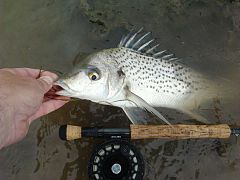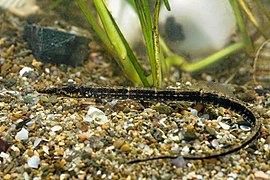Arhythmacanthidae is a family of parasitic worms from the order Echinorhynchida.[2]
| Arhythmacanthidae | |
|---|---|
| Scientific classification | |
| Domain: | Eukaryota |
| Kingdom: | Animalia |
| Phylum: | Acanthocephala |
| Class: | Palaeacanthocephala |
| Order: | Echinorhynchida |
| Family: | Arhythmacanthidae Yamaguti, 1935 |
| Synonyms[1] | |
| |
Species
There are 9 genera in the family Arhythmacanthidae which contains the following species:[3][a]
Acanthocephaloides
Acanthocephaloides Meyer, 1932 contains several species:
- Acanthocephaloides claviformis Araki & Machida, 1987
Found off Japan. The proboscis has 14 rows each of 6 hooks and 2 spines and the trunk has an anterior swelling. The apical hooks are the smallest; posterior hook largest, reaching up to 74 um. Hook and spine roots (when present) invariably simple, posteriorly directed, without manubria. Trunk spines are markedly smaller, with a variable distribution of trunk spines only on the anterior side.[4]
- Acanthocephaloides cyrusi Bray, Spencer-Jones & Lewis, 1988
A. cyrusi has been found parasitizing the fish: Blackhand sole (Pegusa nasuta referred to by its synonym Solea bleekeri) and the Small-spotted grunter (Pomadasys commersonnii) in Lake St. Lucia, Natal, South Africa. It is distinguished from the other species in the genus Arhythmacanthidae by the more greater sexual dimorphism in length, differing arrangement of hooks, the proboscis with the longest hooks at the anterior-most part and the larger size of proboscis hooks and body spines.[5] Specifically, the proboscis hook rows with 3 spines and 3 hooks that increase in size anteriorly. Apical hook reaches 83–101 or 118–137 um in length and has root with large, oblique, anterior manubrium. Posterior spines rootless. Whole trunk with regular transverse rows of uniform, acuminate, 13–22 um long spines.[4]
- Acanthocephaloides delamuri (Parukhin, 1989) Amin, 2013
- Acanthocephaloides distinctus Golvan, 1969
- Acanthocephaloides geneticus (Buron, Renaud & Euzet, 1985)
Found off the Mediterranean coast of France.[4]
- Acanthocephaloides ichiharai Araki & Machida, 1987
Found off Japan. The proboscis has variable 13–14 (rarely 12 or 16) hook rows of 10–12 hooks/spines (9 hooks and 3 rootless spines in 1 specimen). Hook and spine roots (when present) invariably simple, posteriorly directed, without manubria with the apical hook being the smallest; posterior hook largest, and reaching up to 74 um. The trunk is cylindrical and has spines only on the anterior portion smaller than probiscus hooks and variable in their distribution.[4]
- Acanthocephaloides irregularis Amin, Oğuz, Heckman, Tepe & Kvach, 2011[4]
A. irregularis is found parasitizing the Combtooth blenny (Parablennius zvonimiri) in the Gulf of Odesa, Ukraine, the Mushroom goby (Ponticola eurycephalus) in the Sukhyi Estuary, in the Black Sea, and the Tubenose goby (Proterorhinus marmoratus) and Black-striped pipefish (Syngnathus abaster) in both locations. The species is named for its irregular distribution of trunk spines. A. irregularis is most similar to its closest relative, A. propinquus in proboscis shape and armature as both have 12 longitudinal rows of 5 hooks each and the shape of the trunk, reproductive system and lemnisci. A. irregularis differs from A. propinquus in having randomly distributed trunk spines that are organised in circular rings of individual spines separated by aspinose zones. A. irregularis is also unique in having an anterior trunk collar, a very large triangular cephalic ganglion, nucleated pouches at the posterior end of the proboscis receptacle, and hooks and spines with roots bearing anterior manubria. It is the tenth species of the genus to be described.[4]
- Acanthocephaloides neobythitis (Yamaguti, 1939) Amin, 2013
- Acanthocephaloides nicoli (Kumar, 1992) Amin, 2013
- Acanthocephaloides plagiusae Santana-Pineros, Cruz-Quintana, Centeno-Chale & Vidal-Martinez, 2013
- Acanthocephaloides propinquus (Dujardin, 1845)
A. propinquus was found parasitizing Uranoscopus scaber, Gobius niger, Gobius cobitis, Merluccius merluccius, Scorpaena scrofa, Eutrigla gurnardus, and Solea vulgaris in the bay of Gemlik, Turkey.[6] It is also found in the Atlantic Ocean, Mediterranean Sea and Black Sea.[4] The body is between 2600 and 6237 μm long and between 140 and 280 μm wide. The eggs were between 30 and 64 μm long and 10 to 16 μm wide.[6]
- Acanthocephaloides rhinoplagusiae (Yamaguti, 1935) Amin, 2013
- Acanthocephaloides spinicaudatus (Cable & Quick, 1954) Pichelin & Cribb, 1999
Found off Puerto Rico.[4]
Bolborhynchoides
Bolborhynchoides Achmerov and Dombrovskaja-Achmerova, 1959 contains one species.
- Bolborhynchoides exiguus (Achmerow & Dombrowskaja-Achmerova, 1941)
Breizacanthus
Breizacanthus Golvan, 1969 contains many species:
- Breizacanthus aznari Hernández-Orts, Alama-Bermejo, Crespo, García, Raga & Montero, 2012[7]
- Breizacanthus chabaudi Golvan, 1969
Infests the Striped red mullet (Mullus surmuletus).[8]
- Breizacanthus golvani Gaevskaja & Shukhgalter, 1984
- Breizacanthus irenae Golvan, 1969
- Breizacanthus ligur Paggi, Orecchia & Della Setta, 1975
Euzetacanthus
Euzetacanthus Golvan and Houin, 1964 contains three species:
- Euzetacanthus chorinemusi Gupta & Naqvi, 1984
- Euzetacanthus golvani Gupta & Fatma, 1985
- Euzetacanthus simplex (Rudolphi, 1810)
Heterosentis
Heterosentis Van Cleave, 1931 contains several species:
- Heterosentis brasiliensis Vieira, Felizardo & Luque, 2009
- Heterosentis fusiformis (Yamaguti, 1935) Tripathi, 1959
- Heterosentis heteracanthus (Linstow, 1896) Van Cleave, 1931
H. heteracanthus was found parasitizing Patagonotothen longipes, Patagonotothen tessellata and Champsocephalus esox in the eastern mouth of the Beagle Channel.[9]
- Heterosentis hirsutus Pichelin & Cribb, 1999[10]
- Heterosentis holospinus Amin, Heckman & Ha, 2011[11][12][13]
H. holospinus has been found parasitizing the Striped eel catfish (Plotosus lineatus), in Halong Bay, Vietnam.[11]
- Heterosentis martini Lanfranchi & Timi, 2011
- Heterosentis mongcai Amin, Heckmann & Ha, 2014
- Heterosentis mysturi Wei, Huang, Chen and Jiang, 2002
- Heterosentis overstreeti (Schmidt & Paperna, 1978) Amin, 1985
- Heterosentis paraplagusiarum (Nickol, 1972) Amin, 1985
- Heterosentis plotosi (Yamaguti, 1935) Schmidt & Paperna, 1978
- Heterosentis septacanthus (Sita in Golvan, 1969) Amin, 1985
- Heterosentis thapari (Gupta & Fatma, 1979) Amin, 1985
- Heterosentis zdzitowieckii (Kumar, 1992) Pichelin & Cribb, 1999
Hypoechinorhynchus
Hypoechinorhynchus Yamaguti, 1939 has several species:
- Hypoechinorhynchus alaeopis Yamaguti, 1939
- Hypoechinorhynchus golvani Gutpa & Kumar, 1987
- Hypoechinorhynchus magellanicus Szidat, 1950
H. magellanicus was found parasitizing Champsocephalus esox in the eastern mouth of the Beagle Channel.[9]
- Hypoechinorhynchus robustus Pichelin, 1999
- Hypoechinorhynchus thermaceri Buron, 1988
Paracanthocephaloides
Worms in this Paracanthocephaloides Golvan, 1969 have no trunk spines.[4]
- Paracanthocephaloides caballeroi (Gupta & Fatma, 1983) Bhattacharya, 2007
- Paracanthocephaloides chabanaudi (Dollfus, 1951)
- Paracanthocephaloides incrassatus (Molin, 1858) Meyer, 1932
- Paracanthocephaloides tripathii Golvan, 1969
Solearhynchus
The proboscis hooks in Solearhynchus de Buron and Maillard, 1985 gradually decrease in size posteriorly.[4]
- Solearhynchus kostylewi (Meyer, 1932)
S. kostylewi was found parasitizing Solea vulgaris in the bay of Gemlik, Turkey. The body was between 7404 and 7854 μm long and 739 and 1040 μm wide. Theanterior part of the body was wider than the posterior. The proboscis was cylindrical and armed with 16 rows of hooks each with 5 or 6 hooks the longest hooks being in the middle of the proboscis. The smallest basal spinelike hooks were unrooted. The testes were located centrally in the body distant from the six cement glands. The eggs measured between 42 – 64μm long and between 12 and 20μm wide.[6]
- Solearhynchus soleae (Porta, 1905)[b]
S. soleae was found parasitizing Solea vulgaris in the bay of Gemlik, Turkey. The body was from 5382 to 20328 μm long and 693 to 1200 μm wide. The proboscis was from 224 – 320 μm long and the proboscis sac was between 277 and 480 μm long. The proboscis has 12 – 14 rows of hooks each comprising 5 or 6 hooks. The longest hooks were in the middle of the proboscis and the smallest basal hooks were unrooted and resembled spines. The lemnisci were longer than the proboscis sac, measuring between 312 and 350 μm and between 312 – 349 μm long. Males had two testes in the posterior part of the body distant from six piriform cement glands. The eggs measured between 56 and 68 μm long and between 12 and 20 μm wide.[6] This species was also recorded in the Black Sea by Belofastova and Korniychuk (as the synonym Acanthocephaloides rhytidotes).[6] The species name soleae derives from the genus name of the host, the Adriatic sole (Originannly named Solea impar, now named Pegusa impar).[6]
Spiracanthus
Spiracanthus Muñoz and George-Nascimento, 2002 has one species
- Spiracanthus bovichthys Munoz & George-Nascimento, 2002
Yamagutirhynchus
Yamagutirhynchus has two species:[14]
- Yamagutirhynchus elliotae Smales 2023
- Yamagutirhynchus lymberyi Smales 2023
Hosts
Arhythmacanthidae species parasitize fish.
- Hosts for Arhythmacanthidae species
- The Small-spotted grunter is a host of Acanthocephaloides claviformis.
- The Combtooth blenny is one of the hosts of Acanthocephaloides irregularis.
- The Mushroom goby is one of the hosts of Acanthocephaloides irregularis.
- The Tubenose goby is one of the hosts of Acanthocephaloides irregularis.
- The Black-striped pipefish is one of the hosts of Acanthocephaloides irregularis.
- Heterosentis holospinus parasitizes the Striped eel catfish.





